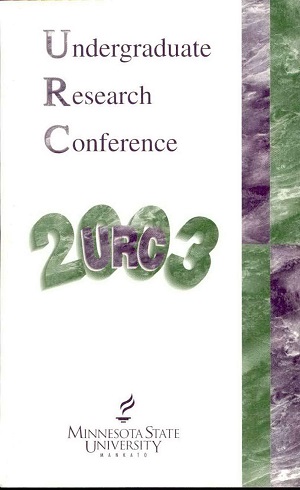Food Habits of the Hoary Bat (Lasiurus cinereus) in Southwestern Minnesota
Location
CSU
Student's Major
Biological Sciences
Student's College
Science, Engineering and Technology
Mentor's Name
Brock R. McMillan
Mentor's Department
Biological Sciences
Mentor's College
Science, Engineering and Technology
Description
The hoary bat is one of the most widespread bats in North America and is the largest bat found in the state of Minnesota. However, little of the natural history is known for this species due to its solitary, tree-roosting, and lowdensity lifestyle. As part of a larger project, more than 100 hoary bat carcasses were collected during the summers of 2000-2002 at the Buffalo Ridge Wind Resource Area in southwestern Minnesota. This collection was very large and provided a unique and important opportunity to examine the food habits of the hoary bat. Gastrointestinal tracts were dissected from all bats that were not in late stages of decomposition. Contents of the stomach and fecal pellets were sorted and identified to Family by comparing the fragments in the samples to insects that were sampled and collected in the study area. There were 25 bats that were in suitable condition for examination. Preliminary data suggests that hoary bats in southwestern Minnesota feed on members of Class Insecta, primarily from Order Lepidoplera (butterflies and moths), Order Coleoptera (beetles), and Order Hemiptera (true bugs). These results are consistent with the limited reports for this species from other geographic regions.
Food Habits of the Hoary Bat (Lasiurus cinereus) in Southwestern Minnesota
CSU
The hoary bat is one of the most widespread bats in North America and is the largest bat found in the state of Minnesota. However, little of the natural history is known for this species due to its solitary, tree-roosting, and lowdensity lifestyle. As part of a larger project, more than 100 hoary bat carcasses were collected during the summers of 2000-2002 at the Buffalo Ridge Wind Resource Area in southwestern Minnesota. This collection was very large and provided a unique and important opportunity to examine the food habits of the hoary bat. Gastrointestinal tracts were dissected from all bats that were not in late stages of decomposition. Contents of the stomach and fecal pellets were sorted and identified to Family by comparing the fragments in the samples to insects that were sampled and collected in the study area. There were 25 bats that were in suitable condition for examination. Preliminary data suggests that hoary bats in southwestern Minnesota feed on members of Class Insecta, primarily from Order Lepidoplera (butterflies and moths), Order Coleoptera (beetles), and Order Hemiptera (true bugs). These results are consistent with the limited reports for this species from other geographic regions.



